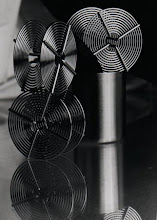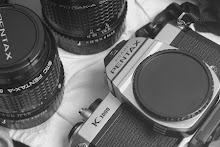
Cold "homemade slide" look from CTO full gel counter-balanced
with a hard temperature adjustment in post.
by John O'Keefe-Odom
AgXphoto.info
You've got about 15 minutes to get the photo done; they want it for web publicity, and you have no idea what kind of look will go with their music. What kind of plan can you come up with that will present a subject's personality, from personable to vicious, in one setup?
I laid on a full CTO from the left; blasted white from the right, aimed at their black shirts. Roughly half of the photos were also cut with single point lighting; with the CTO at full power on the left.
Sometimes we can overlook the influence of color temperature on monochrome conversions of digital photos. Why use a CTO instead of just plain clamshell lighting? Underpainting.
It's an old trick, used by master painters for hundreds of years. Color temperature can be used to turn the shape of a form. In this case, the forms will wrap from warm to cold, depending on their shape. Warm up one side, or cool down the other, and you can accentuate the tonal changes on round forms in traditional two dimensional illustration.
To vary things further, in post I made changes to the pictures overall color temperature. Meanwhile, the CTO will affect only those surfaces it hit. This means that by choosing what the CTO hits, we can have some forms appear to turn, while others can appear to remain flat.
.jpg)
Normal figure forms on the left to flat, litho-like on the right.
From full form curves on the left to almost flat on the right, while maintaining a flat-appearing background. This frame was single point with full CTO at camera left, from the lighting plan that was already in place.
How strong of an effect that you can achieve with this can be controlled with the intensity of the light striking the subject (subject to flash distance) and the intensity of the coloring of the light. In this case, it's a full CTO.
different heights and temperatures on the strobes.
Lighting diagram for the setup. CTO full on camera left, a little high.
White strobe on camera right, aimed for the chest, to help illuminate
the black shirts the subjects wore.
Camera heights and flash heights relative to the subject.
.jpg)
Downward strobe angle and distance of flash to subject can help us move from rounded forms (figure left) to flatter subjects (camera right). Notice, the figure on the right is positioned so that the light striking the side of the face is at a strong, obtuse angle to the camera's lateral axis. Meanwhile, the figure on the left maintains a strobe to subject to camera lateral angle of closer to 90 degrees.
My runs also include frequent standardized changes in
black point.
Background conditions, by time of day choice,
gave us a very dark, almost black, set of greens
in the background.
while maintaining drapery in the black fabric.

Colder blue temperature over the camera-recorded
CTO and white. Notice, the post-process changed the
whole image's temperature, but the CTO affected
only those surfaces its light hit.
# # #













No comments:
Post a Comment